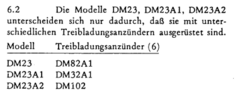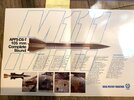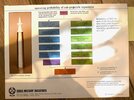The 105x617 DM23 projectile is produced in Israel and is the for Germany produced version of the Israeli M111 Hetz projectile.
The DM23 projectile consists of an aluminum ballistic cap (A), screwed unto a Tungsten penetrator (C). Inside the ballistic cap, there are 3 Tungsten cylinders (B). Between the cap and the first cylinder are two spring washers. the ballistic cap, the 3 cylinders and the penetrator are glued together.
The 3 cylinders are meant to prepare the impact point for the penetrator. The cylinders reduce the chance of a ricochet and improve penetration.
The Sabot (E) consists of 3 major parts. The front of the sabot has 6 holes (two per part). The front of the sabot also has an aluminum ring (D), as does the bottom part (H). These rings hold the sabot together. The rings have pre-fabricated weak points, that will break when the sabot encounters wind resistance after leaving the barrel, allowing the sabot parts to move away from the penetrator. The sabot has indentations on the inside, that match rings on the outside of the penetrator. These rings and indentations are radial, not screw thread shaped, allowing the penetrator to turn freely in the sabot. This prevents transfer of rotation from the rifled barrel on the sabot to the penetrator. The sabot has a rubber ring (I) that creates a gas seal inside the sabot. The outside of the sabot has a plastic gas seal (G) that can slide over another plastic glide ring (F). Even under pressure, these rings can move independently of each other, to prevent imparting spin from the rifled barrel unto the penetrator.
The end of the penetrator has a steel fin assembly, containing a tracer element.
After firing of the cartridge, the projectile leaves the barrel of the gun, the wind resistance breaks the aluminum rings and forces the sabot open, pushing the parts outward. The penetrator flies forward to the target and penetrates the armour by using direct pressure on a very small surface area.
Technical data:
Projectile Weight: 6.2 Kg
Penetrator Weight: 4.2 Kg
Muzzle velocity: 1450 m/s
Maximum range at 10 degrees elevation: 30.9 Km
Models DM23, DM23A1 and DM23A2 only differ in the electric primer used in the cartridge case.



The DM23 projectile consists of an aluminum ballistic cap (A), screwed unto a Tungsten penetrator (C). Inside the ballistic cap, there are 3 Tungsten cylinders (B). Between the cap and the first cylinder are two spring washers. the ballistic cap, the 3 cylinders and the penetrator are glued together.
The 3 cylinders are meant to prepare the impact point for the penetrator. The cylinders reduce the chance of a ricochet and improve penetration.
The Sabot (E) consists of 3 major parts. The front of the sabot has 6 holes (two per part). The front of the sabot also has an aluminum ring (D), as does the bottom part (H). These rings hold the sabot together. The rings have pre-fabricated weak points, that will break when the sabot encounters wind resistance after leaving the barrel, allowing the sabot parts to move away from the penetrator. The sabot has indentations on the inside, that match rings on the outside of the penetrator. These rings and indentations are radial, not screw thread shaped, allowing the penetrator to turn freely in the sabot. This prevents transfer of rotation from the rifled barrel on the sabot to the penetrator. The sabot has a rubber ring (I) that creates a gas seal inside the sabot. The outside of the sabot has a plastic gas seal (G) that can slide over another plastic glide ring (F). Even under pressure, these rings can move independently of each other, to prevent imparting spin from the rifled barrel unto the penetrator.
The end of the penetrator has a steel fin assembly, containing a tracer element.
After firing of the cartridge, the projectile leaves the barrel of the gun, the wind resistance breaks the aluminum rings and forces the sabot open, pushing the parts outward. The penetrator flies forward to the target and penetrates the armour by using direct pressure on a very small surface area.
Technical data:
Projectile Weight: 6.2 Kg
Penetrator Weight: 4.2 Kg
Muzzle velocity: 1450 m/s
Maximum range at 10 degrees elevation: 30.9 Km
Models DM23, DM23A1 and DM23A2 only differ in the electric primer used in the cartridge case.

















